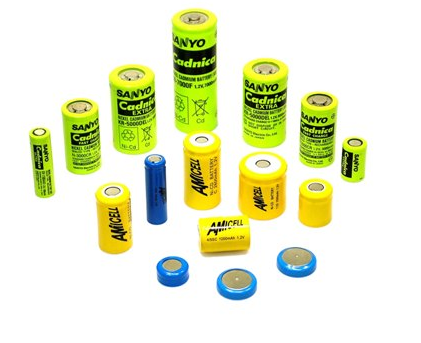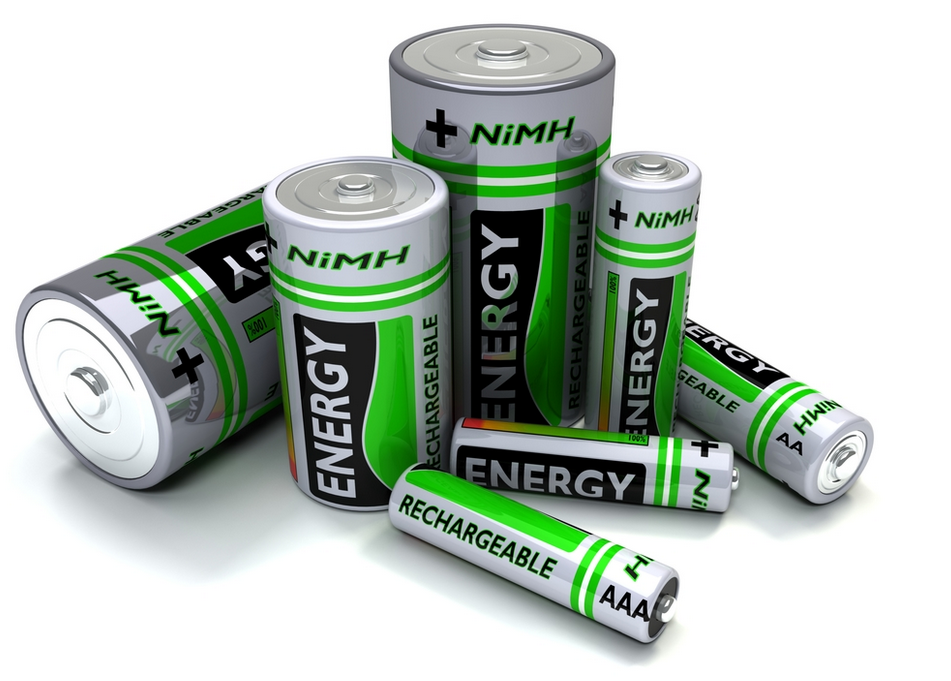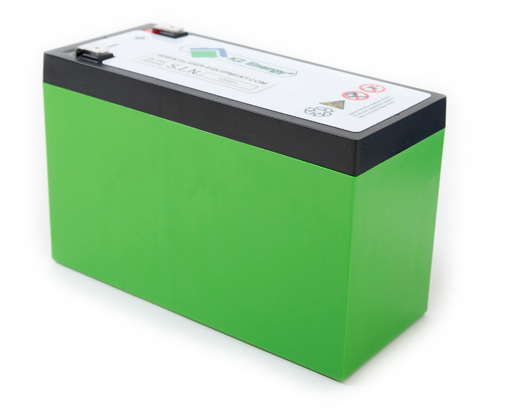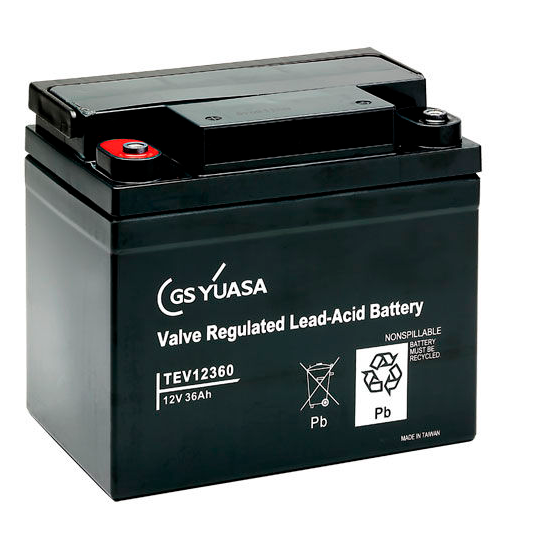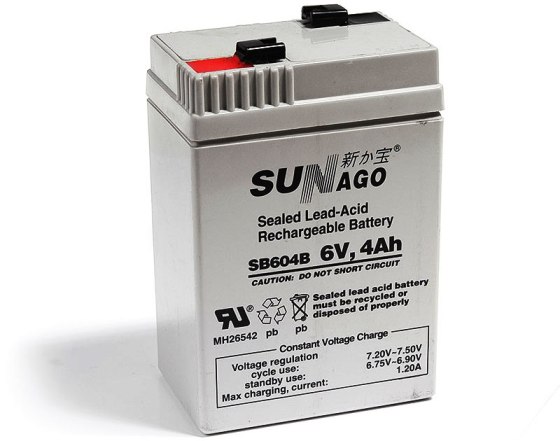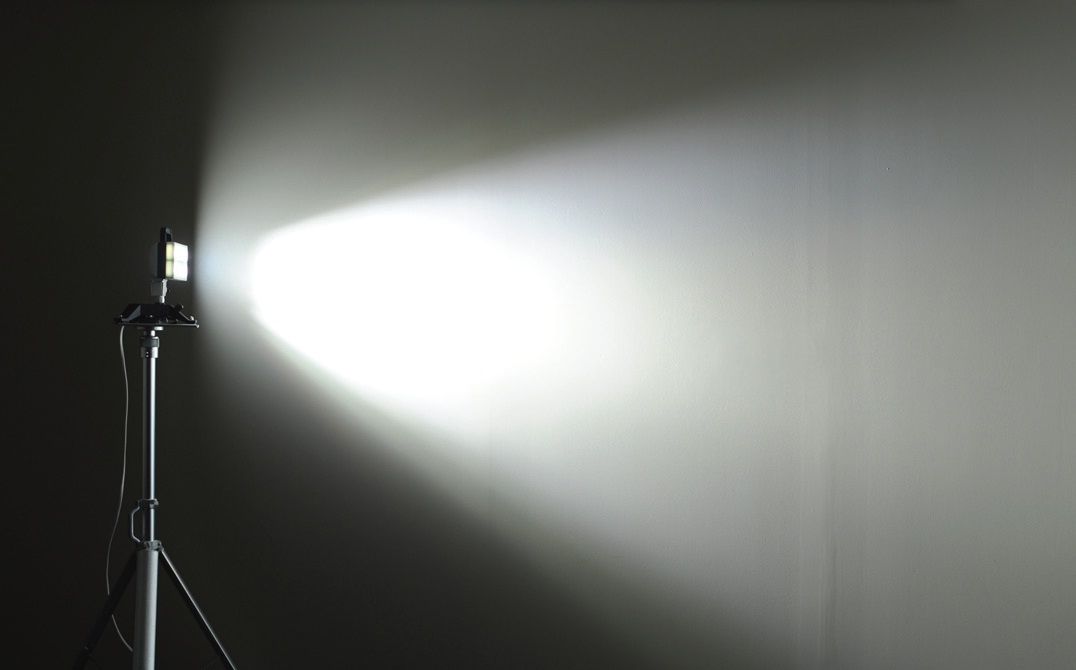Battery Types used in Solar Flood lights, and What you Need To Know about Each of them
Ni-Cd battery
What are Ni-Cd batteries?
Ni-Cd (Nickel-Cadmium) are type of rechargeable batteries, usually few AA or AA type batteries pack, that are used in many consumer electronic products including solar flood lights. Ni-Cd batteries were really popular before 1990s, until the superior Ni-MH and Lithium batteries were introduced. The chemical abbreviation NiCd means that batteries contain two chemical substances Ni (Nickel) and Cd (Cadmium). It uses Nickel oxide hydroxide as the positive electrode and metallic Cadmium hydroxide as negative electrode, and the electrolyte is Potassium hydroxide. Ni-Cd batteries can be used in many different application such as clocks, remote-controls, RC toys, flashlights, different portable electronic devices and more, but today, they are mostly used in different power tool application that demands high amount of power. As mentioned above, Ni-Cd batteries can be used individually, or into battery packs of many. The closest competitor to Ni-Cd batteries are Ni-MH batteries, because both are used in smaller solar flood lights with less light output power. That is why, when comparing different battery types, these two are usually compared one by other.
Ni-Cd battery advantages for solar flood lights
- Longer life charge and discharge cycles – Typical Ni-CD battery will have similar or more charge and discharge cycle durability than Ni-MH battery (about 2000 compared to 500 – 200 for Ni-MH).
- Lower self discharge rate – Self discharge rate is measured, when battery is not used and connected to any device. Ni-CD batteries will have significantly lower self discharge rate – about 10% a month, while Ni-MH batteries have higher 30% self discharge rate per month, if they are left in identical conditions.
- More tolerance against overheating unlike Ni-MH – Overheating of battery is almost always done by overcharging it, and that can cause lot of damage to the battery. In this case, Ni-Cd batteries can handle more heat than Ni-MH batteries, and will not fail so fast if overcharged.
Ni-Cd battery disadvantages for solar flood lights
- Low battery capacity – The biggest disadvantage for Ni-Cd batteries is their low capacity, it is almost three times lower than for Ni-MH batteries. This means that Ni-MH battery will work for much longer time than Ni-Cd battery with one full charge. This is the main reason, why Ni-MH batteries became so popular and started replacing Ni-Cd type batteries.
- Memory effect – Ni-Cd batteries may have a memory effect. This means that when battery gets discharged many times to one certain level and then charged full again, the battery will act as this level is the discharge point of the battery, and every time the battery discharges, it will drop to zero, when it reaches this “remembered” point. Thats why Ni-Cd batteries need to be discharged till the end and then charged fully again from time to time, to avoid this memory problem.
- Toxic – Cadmium used in Ni-Cd batteries is toxic and dangerous to environment. That’s why they need to be recycled by proper recycling center, that is specialized in Ni-Cd battery recycling and disposing.
The power in voltage produced by both Ni-Cd and Ni-MH batteries are practically the same.
What type of solar flood lights uses Ni-Cd batteries?
Ni-Cd batteries are primarily used for smaller solar flood lights that have lower power and level of brightness. As these solar flood lights do not require as much energy to be able to illuminate from dusk to dawn as larger flood lights with more than 40 LED diodes, the Ni-Cd batteries can hold enough charge to power smaller LED solar flood lights for all night. Ni-Cd batteries are mostly used in packs of more than 3 in different solar flood lights.
Ni-MH battery
What are Ni-MH batteries?
Ni-MH batteries (Nickel – Metal Hydride) are the most popular type of rechargeable batteries used in lower power solar flood lights. These batteries used in solar lighting are in AA type or pack of AA type batteries. Ni-MH batteries are somewhat similar to Ni-Cd batteries, but in opposite to Cadmium used in Ni-Cd batteries for negative electrodes, Ni-MH batteries use a hydrogen-absorbing alloy. Usage of this material in Ni-MH batteries has got its advantages that made them supreme over older Ni-Cd batteries. First Ni-MH batteries were available before 1990s and became very popular, replacing older Ni-Cd rechargeable batteries in many consumer electronic products. Ni-MH batteries are used in all sorts of electronic devices, starting from consumer electronics like different remotes, lights, vacuum cleaners, radios, to more advanced technologies like batteries for electric hybrid vehicles. The usage of Ni-Cd batteries were heavily impacted by EU Battery Directive. This directive meant that sales of Ni-Cd batteries were banned in EU, due to its Cadmium toxic element. Ni-Cd batteries are allowed only for medical use, emergency lighting, portable power tools. In result, Ni-MH batteries replaced Ni-Cd in practically all electronics, where Ni-Cd rechargeable batteries were used.
Ni-MH battery advantages for solar flood lights
- Higher capacity – Ni-MH batteries have got much higher capacity compared to Ni-Cd batteries. The average capacity of Ni-MH battery is 2000 mAh for AA type battery, compared to average 600 mAh for Ni-Cd battery. This means that Ni-MH can work significantly more hours with full charge than Ni-Cd batteries can. This is one of the main reasons, why Ni-MH batteries are lot more popular and widely used in consumer electronics.
- No memory effect – Instead of Ni-Cd batteries, Ni-MH batteries has got no significant memory effect. This means that battery can be discharged to same point for many times, and it will not cause any visible effect on battery life.
- Environment friendly – Ni-MH batteries do not contain toxic Cadmium metal, and so are more environmentally friendly.
- LSD Ni-MH – In 2005 LSD Ni-MH or low self discharge nickel-metal hydride battery was firstly introduced for consumers. These batteries have much lower self discharge rate. This means that LSD Ni-MH batteries will hold charge for longer period of time, if they are not used. They will retain about 80% of their capacity after year of storage, which is a lot compared to regular Ni-MH batteries. However, due to this feature, they have lower capacity than standard Ni-MH battery.
Ni-MH battery disadvantages for solar flood lights
- High self discharge rate – Regular Ni-MH batteries have high discharge rate for up to 30% a month. However, LSD Ni-MH batteries have much lower discharge rate than regular Ni-MH batteries, at about 30% a year.
- Over-discharge – Ni-MH batteries have risk of over-discharging. In a pack of Ni-MH batteries, if one battery discharges in different rate than others, it goes into over-discharge and reverses the polarity that causes permanent damage to the battery.
What type of solar flood lights uses Ni-MH batteries?
Ni-MH batteries are used for most smaller, lower brightness LED solar flood lights. Ni-MH batteries are the most popular battery type for such solar floodlights, and are used in lot more floodlights than Ni-Cd batteries. This is because they have almost three times higher capacity, which is useful for solar flood lights, because they need more power to provide illumination for all night, and Ni-MH batteries are much better to do the job than Ni-Cd batteries. Also using motion sensor with your solar flood light will provide longer illumination time at night for your solar flood light.
LiFePO4 battery
What is LiFePO4 battery?
LiFePO4 (Lithium iron phosphate) battery or LFP battery is a type of rechargeable battery that is used in different electronic application and also some high end solar flood lights. It is lithium-ion type of battery and belongs to Lithium battery group. Unlike other Lithium based batteries like Lithium-Ion and Lithium-Polymer, Lithium iron phosphate battery uses LiFePO4 as a cathode material. Lithium iron phosphate battery is the top used rechargeable Lithium battery in chemistry. LiFePO4 batteries are stable, safe, reliable and durable, perfect for all sorts of electronic applications. Also Lithium iron phosphate batteries are the safest type of Lithium batteries, which means they will not overheat and will not catch fire. LFP batteries has got lower energy density and it provides longer lifetime and better power density, also providing high level of safety. LiFePO4 cathode used in these batteries is not hazardous, so it does not put any danger and hazard to environment. The Lithium iron phosphate was first introduced in 1996 as new cathode material for rechargeable lithium batteries. LiFePO4 batteries are used in many types of applications, from smaller consumer electronics to different transportation uses. Lithium iron phosphate batteries are used in few RC models, different lighting solutions including solar flood lights, solar energy systems, and because of its lower weight also in electric bicycles, motorcycles and cars and other types of electric vehicles. LiFePO4 battery average service life is approximately 6 – 7 years.
LiFePO4 battery advantages for solar flood lights
- Long cycle life – up to 2000 cycle life, longer than other Lithium-ion rechargeable batteries and longer than Lead Acid batteries.
- Long service life – About 6 – 7 years.
- Constant discharge voltage – Like Ni-MH and Ni-Cd batteries, LiFePO4 has got constant discharge voltage, staying close to 3.2V during discharge.
- High theoretical and practical capacity.
- Safe and stable – no danger of explosion and will not catch fire if overcharged or short circuit.
- Wide temperature range – from -4 F to 150 F (-20 C to +70 C).
- Fast charging – charges fully in very short time.
- Light, flexible and small form factor.
- Environment friendly – no toxic substances.
LiFePO4 battery disadvantages for solar flood lights
- More expensive than Lead-acid batteries.
- Lower energy density – Energy density of Lithium iron phosphate battery is lower than Lithium-ion battery.
- Low discharge rate – LFP have lower discharge rate compared to lead-acid and lithium-ion batteries.
- Lower temperatures impact battery – Lithium iron phosphate battery will have problems working at lower temperatures than -20 C, while lead-acid batteries can work in even as low as -40 degrees C.
What type of solar flood lights uses LiFePO4 battery?
LiFePO4 or Lithium iron phosphate batteries are used on higher end LED solar flood lights. Currently these types of Lithium batteries are used by few manufacturers, the most popular of which currently is EE Systems Group. They use LFP batteries in eLEDing solar flood lights. Also companies that supports green lifestyle and tries to make their products more environmentally friendly uses LiFePO4 batteries in their products, as they do not contain any toxic substances in opposite to competing Lead-acid batteries.
Lead-acid battery
What is Lead-acid battery?
Lead-acid batteries are one of the oldest battery types that are widely used today, also in solar flood lights. Lead-acid batteries were invented in 1859 and were the first type of rechargeable batteries that were used commercially. Lead-acid battery is able to provide high surge currents and has got high power based on the battery weight. Although Lead-acid batteries have low energy to weight and energy to volume ratio, high power and low cost properties makes these batteries a widely used product in many technologies that need high current, such as car starter, so Lead-acid batteries can mostly be found as car accumulators. Lead-acid battery electrodes and grids are all manufactured from lead. As electrolyte a sulfuric acid is used. Basic Lead-acid batteries have been used for long time in vehicle manufacturing industries as automotive engine start. These batteries used as engine starters are called SLI or Starting Lighting and Ignition. One of the most popular type of Lead-acid batteries is VRLA (valve-regulated lead-acid) battery. VRLA batteries are also known as sealed batteries or maintenance free batteries. VRLA batteries are used in powerful solar led outdoor flood lights. The advantage of VRLA batteries is that they can be used and mounted in any direction, thanks to the sealed casing, and they do not require any maintenance, also they can be used in low ventilated places, that is why they are used in portable electronic devices. Lead-acid batteries are mostly used in automotive vehicles, as emergency electrical installations, in UPS, in different powerful lightings including solar flood lights and in high current drain applications, also valve-regulated lead-acid batteries are used in different large, portable electronic equipment.
Lead-acid battery advantages for solar flood lights
- Cheaper and easy to make – Lead-acid battery is inexpensive and quite easy to manufacture. Lead-acid batteries have low cost per watt hour.
- Low self-discharge – Lead-acid battery has got the lowest self-discharge rate among rechargeable batteries. For example, while Lead-acid battery loses 40 percent energy in a year, Ni-Cd battery loses about the same amount of stored energy just in three months.
- High power – Lead-acid battery provides high power based on battery weight, and can provide high discharge currents.
- Performs well in low and high temperatures – Lead-acid batteries work well in subzero conditions unlike Lithium-ion batteries. They can operate in temperatures from -40 degrees C to 50 degrees C.
Lead-acid battery disadvantages for solar flood lights
- Heavy and less durable – Lead-acid batteries are more heavy and less durable than competing nickel and lithium based batteries, when they are deep-cycled. Also they have limited cycle life and repeated deep-cycling reduces battery life to about 200 – 300 charge and discharge cycles
- Low specific energy – Lead-acid batteries have got low specific energy and poor energy to weight and energy to volume ratio
- Slower charging – Lead-acid batteries take about 14 hour to fully charge
- Sulfation – Lead-acid batteries must stored in charged condition to prevent sulfation process
- Unfriendly for environment – Lead-acid batteries are so popular because of their low manufacturing costs and not their safety for environment. Although car battery recycling is one the most popular recycling industries, still some part of Lead-acid car batteries gets polluted into environment. Lead used in Lead-acid batteries is highly toxic for humans and environment.
What type of solar flood lights uses Lead-acid battery?
Lead-acid batteries are used in large and powerful outdoor solar floodlights with more than hundred LED diodes that provides more hundreds of lumens light output power. These batteries are cheaper, so more expensive solar flood lights can cut down price by using these types of batteries. Lead-acid battery type used in solar flood lights is VRLA (valve-regulated lead-acid). This means that they can be operated and installed in any direction without danger of liquids spilling out of the battery, and they are maintenance free, so no additional maintenance is needed for this type of battery. Lead-acid batteries can operate in much lower temperatures, down to – 40 degrees C, so you can use them in winter and they will work without any power losses, so they are used in outdoor LED lights.
Here is a presentation about Solar Flood Light battery types for those, who do not want to read the full article

